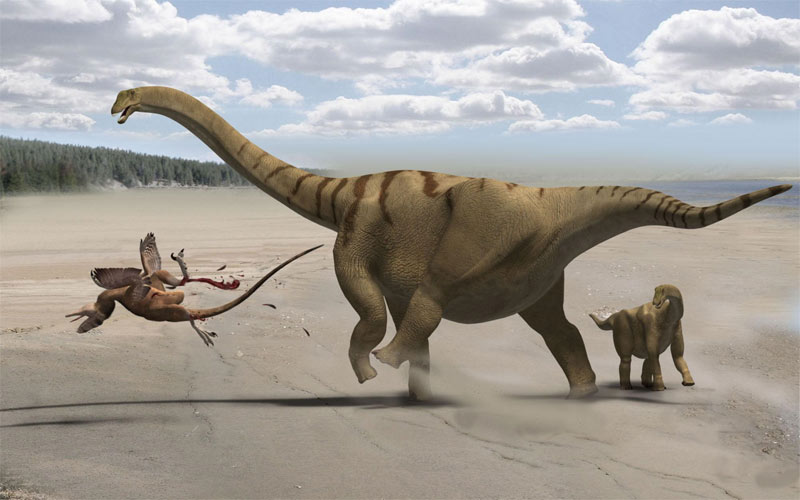First Long-Necked Dinosaur Fossil Found In Antarctica

LAS VEGAS — It's official, long-necked sauropod dinosaurs once roamed every continent on Earth — including now-frigid Antarctica.
The discovery of a single sauropod vertebra on James Ross Island in Antarctica reveals that these behemoths, which included Diplodocus, Brachiosaurus and Apatosaurus, lived on the continent in the upper Cretaceous Period about 100 million years ago.
"Sauropods were found all around the world, except Antarctica," said study researcher Ariana Paulina Carabajal, a paleontologist at the Carmen Funes Municipal Museum in Plaza Huincul, Argentina. "Until now."
Paulina Carabajal reported the find Nov. 3 here at the annual meeting of the Society for Vertebrate Paleontology.
Fossils at the South Pole
Paulina Carabajal and her colleagues aren't the first to find a dinosaur in Antarctica. Paleontologists turned up an ankylosaur bone in 1986, and since then, there have been other dinosaur specimens, including duck-billed dinosaurs. Nonetheless, the continent hasn't been as fertile a fossil-hunting ground as other regions. [Image Gallery: Dinosaur Fossils]
"There are probably a lot of dinosaurs in Antarctica, but we haven't found them yet, because it's very difficult to go to Antarctica and then it's very difficult to find [fossils]," Paulina Carabajal told LiveScience. "And, of course, a lot of the continent is covered in ice."
Sign up for the Live Science daily newsletter now
Get the world’s most fascinating discoveries delivered straight to your inbox.
Even in the summer, when ice and snow retreat in some coastal areas, finding fossils is difficult, she said. Daily cycles of freezing and thawing crack bones to pieces, so "you will never find a complete bone," Paulina Carabajal said. And after about 8 inches (20 centimeters) of digging, you run into the permafrost, which is too hard to excavate without waiting for it to melt for a day or two.
Paulina Carabajal and two colleagues flew to James Ross Island by helicopter, which dropped them off with their camping equipment.
"When the helicopter leaves you there just with boxes and goes back to the base … you feel like ‘Ooh, what am I doing here?’" Paulina Carabajal said.
But she soon fell in love with the peaceful, chilly island, she said, and the group began surveying for fossils. They found a number of marine reptiles, fish and invertebrates, Paulina Carabajal said, but no dinosaurs until the end of their stay, when they went to the site where the first Antarctic ankylosaur was found. There, at the surface, they found a single broken sauropod vertebra.
"We cannot do much with only a vertebra, so we don't know the genera or species," Paulina Carabajal said. "But we know it's a titanosaur, it's a kind of sauropod that's very common in South America."
Long-tailed, long-necked titanosaurs may have weighed more than 100 tons. They were herbivores, armored with tough, beadlike scales.
Ancient Antarctica
When the sauropods roamed the Earth, Antarctica was connected to South America and Australia, so sauropods could have simply walked from present-day continent to present-day continent, Paulina Carabajal said. The landmass of Antarctica itself was not as far south as it is today, so the continent would have been warmer, she said, although far from balmy.
"It was warm enough for these animals to live there," she said.
Beyond showing these long-necks lumbered across every continent, the find may be useful for revealing where and how the animals traveled, Paulina Carabajal said. No one yet knows how sauropods spread across the globe.
"It will be interesting, with time, with more information, to know how these dinosaurs spread around the world using Antarctica like a bridge," she said.
You can follow LiveScience senior writer Stephanie Pappas on Twitter @sipappas.Follow LiveScience for the latest in science news and discoveries on Twitter @livescience and on Facebook.

Stephanie Pappas is a contributing writer for Live Science, covering topics ranging from geoscience to archaeology to the human brain and behavior. She was previously a senior writer for Live Science but is now a freelancer based in Denver, Colorado, and regularly contributes to Scientific American and The Monitor, the monthly magazine of the American Psychological Association. Stephanie received a bachelor's degree in psychology from the University of South Carolina and a graduate certificate in science communication from the University of California, Santa Cruz.









